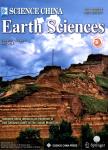Climatic significance of δ^(18)O records from an 80.36 m ice core in the East Rongbuk Glacier, Mount Qomolangma (Everest)
Climatic significance of δ18O records from an 80.36 m ice core in the East Rongbuk Glacier, Mount Qomolangma (Everest)作者机构:Climate Change Institute University of MaineOronoME 04469USA
出 版 物:《Science China Earth Sciences》 (中国科学(地球科学英文版))
年 卷 期:2005年第48卷第2期
页 面:266-272页
核心收录:
学科分类:070903[理学-古生物学与地层学(含:古人类学)] 0709[理学-地质学] 07[理学]
基 金:supported by the National Natural Science Found ation of China(Grant Nos.40205007,49901004 and G1999043400) the Knowledge Innouation Projects of the Chinese Academy of Sciences(CAS)(Grant Nos.KZCX1-10-02 KZCX2-108 and KZCX2-305),US NSF(ATM-013949 1) the interm tional cooperation project Sino-Amen can Ice Core Project on Ro ngbuk Glacier,Mt.Qomolangma
主 题:East Rongbuk ice core δ18O values air temperature Indian Summer Monsoon.
摘 要:The δ18O variations in an 80.36 m ice core retrieved in the accumulation zone of the East Rongbuk Glacier, Mount Qomolangma (Everest), is not consistent with changes of air temperature from both southern and northern slopes of Himalayas, as well as these of the temperature anomalies over the Northern Hemisphere. The negative relationship between the δ18O and the net accumulation records of the ice core suggests the amount effect of summer precipitation on the δ18O values in the region. Therefore, the δ18O records of the East Rongbuk ice core should be a proxy of Indian Summer Monsoon intensity, which shows lower δ18O values during strong monsoon phases and higher values during weak phases.



